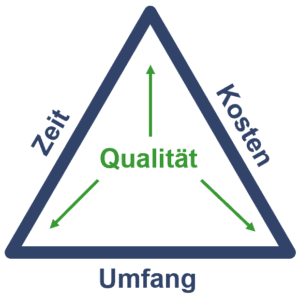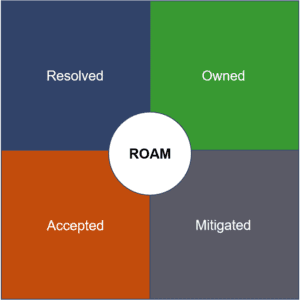
Kevin Düringer
Senior Consultant
Not enough resources, not enough money, or simply not enough time. Sound familiar? In the fast-paced world of software development, projects rarely go according to plan. Unforeseen challenges can create problems for your team and bring your progress to a standstill. In these situations, it’s not always easy to keep your cool. The question is, how can you avoid them? And how can you manage crises and get your project back on track?
Finding the Right Balance: The Magic Triangle
Project management is like a 1,000-piece jigsaw puzzle. You need to fit all the different pieces together to create a beautiful end result. The magic triangle is a helpful way to visualize this challenge. It illustrates the three main factors that need to be considered for every project: scope, time and cost.

Scope: The scope of a project is made up of the project’s specific goals and the tasks that need to be completed. This is the purpose of the project – what exactly needs to be achieved?
Time: The project timeline includes all the different phases – from defining milestones to setting deadlines for individual phases all the way to completion.
Cost: The cost of a project is the total of all the financial resources required to complete it. This includes man-hours, the cost of materials and all other costs related to the project.
For a project to be a success, you need to strike the right balance between all three factors. Changing one factor will inevitably affect the other two. For example, if you expand the scope of a project, you will either need more time to complete it or more money – or both.
Many of the most common project management problems have the same root cause: an imbalance in the magic triangle. This is where a fourth variable comes into play – quality. The quality of your results is directly influenced by the other three factors. If the balance between scope, time and cost shifts at any point during the project, this will inevitably have a negative impact on quality. For software projects, this can be catastrophic, resulting in increased support work, additional costs and delays.
Risk Management as a Preventive Measure
As the saying goes, “an ounce of prevention is worth a pound of cure.” This is also true when it comes to managing crises, which is why risk management is an essential component of project planning and execution. What does that mean exactly? You need to identify risks early on and develop strategies to avoid or manage these risks. One helpful risk management model is ROAM (resolved, owned, accepted, mitigated), which is also used in Scaled Agile Framework (SAFe) PI Planning.
Let’s look at an example of risk management using the ROAM model: in large companies, projects often rely on the work of a single individual with special skills. If this person suddenly has an increased workload or is absent for whatever reason, it can result in a bottleneck or, in the worst-case scenario, bring the whole project to a halt. A fitting response would be to select a responsible person for managing this risk (‘owned’). This person could facilitate knowledge sharing, for example, which would help minimize the risk and ensure that the project can continue even if a key team member is absent. Using the ROAM model, every identified risk is assigned to one of the four categories.

However, effective risk management also means maintaining an overview of the project at all times. Continuous monitoring ensures that your project remains on track and allows you to react quickly to changes.
Mastering the Magic Triangle
If you haven’t defined any preventive measures, or if these measures fail, we recommend taking a closer look at the three corners of the magic triangle. There are always adjustments that you can make in the face of an unexpected challenge or crisis.
Scope: In terms of scope, the key is to stick to the requirements engineering handbook and double-check the quality of the requirements. Using templates to describe the scope of your project allows you to precisely define the key attributes, including utility, description, limits and responsibilities. We also recommend working across flight levels to ensure effective communication, prioritization and transparency. Start at a higher level (Epics) before breaking them down into specific tasks (Stories).
Time: In order to determine how much time your project will take, you’ll need the most accurate estimate possible. The accuracy of your estimate depends on how precisely you’ve defined the scope of your project. The standard practice is to draw up a timeline that takes into account the capacities of all available resources – including all absences. Defining concrete milestones like releases is as important as considering internal and external dependencies. This will allow you to identify critical paths and manage risks accordingly.
Cost: Thorough resource planning is key in terms of cost. For you to handle the defined scope of your project, your planned resources must have all the necessary skills. If you’re working with external partners, always draw up clearly defined agreements on the amount of work (scope or time) you expect from them and ensure a culture fit for a smooth collaboration. In terms of hardware and software costs, it’s important to conduct a careful cost-benefit analysis and compare several different options. Continuous monitoring keeps costs in check and allows you to identify potential overspending early on.
Agile Methods offer Transparency and Flexibility
Crises often weigh heavily on project managers, resulting in a lot of extra stress. In these difficult situations, open communication and transparency are key. Agile methods help you lay the necessary foundation for healthy cooperation by providing you with clearly defined event structures and dedicated teams. For example, regularly scheduled events like stand-ups encourage ongoing discussions on progress, which in turn allow you to proactively tackle blockers. Retrospectives are another essential weapon in your arsenal – they let you see what has worked well in the past as well as what problems you currently face. Taking time to look back not only gives you an opportunity to continually improve your team, but also encourages proactive identification of problems and accelerates problem-solving.
Furthermore, agile methods like Scrum, Kanban and SAFe all involve the incremental delivery of software to ensure that the end product meets all expectations. Every iteration results in a usable product (increment) that is delivered in short cycles. Review events allow you to obtain valuable feedback from stakeholders and make changes so that the project not only stays on track, but also is able to satisfy changing expectations.
Agile methods offer you a number of tangible benefits. Teams and project managers can react quickly and flexibly to problems and changing circumstances, while at the same time ensuring a high level of transparency and clear communication. Agile project management is not merely an effective approach, but rather the key to executing a successful, crisis-free project from start to finish.
We are a partner you can count on when it comes to managing projects of all sizes and complexities as well as overcoming crises calmly and confidently. Thanks to our many years of experience, we are able to optimally support our clients with everything from project evaluation and risk analysis to project planning and realignment. We look forward to guiding you every step of the way and helping you successfully manage your projects.
Share Blog Post
About the Author

Senior Consultant
Continuous willingness to learn and adaptability are a matter of course for me. As a servant leader, I impart these qualities to teams and organizations in order to successfully navigate the path to agility together.

Senior Consultant
Kontinuierliche Lernbereitschaft und Anpassungsfähigkeit sind für mich eine Selbstverständlichkeit. Als Servant Leader vermittle ich diese Eigenschaften den Teams und Organisationen, um gemeinsam erfolgreich den Weg zur Agilität zu beschreiten.
